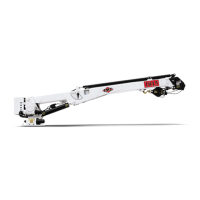99903514:TELESCOPIC CRANE:
2-21 SECTION 2: MAINTENANCE
2-15: ELLS TROUBLESHOOTING PROCEDURE
Each function (winch up, winch down, extension in, etc.) is actuated by a solenoid that shifts the valve spool to
perform the particular function. The solenoids are located on the valve bank. Each solenoid has two wires protruding
with a connector on the end that is plugged into a connector on the wire harness for the crane. There are two wires,
one wire is black (ground) and the other wire is colored. The “ground receptacle” is the receptacle that the black wire
connects to.
A. Find which solenoid actuates which function
-When a solenoid is actuated, it becomes magnetic. By using a piece of steel to find which solenoid is magnetic,
(steel ruler, paper clip, etc.) the solenoids can be matched with which function it controls. It will not be a real strong
magnetic pull, but will be detectable with a small piece of metal.
1. Be sure the truck ignition is on, the parking brake is engaged, and power is “on” to the crane. The PTO does
not need to be engaged.
2. Activate “LOWER UP” on the remote control handle and use the piece of steel to find which solenoid is
magnetic (being actuated).
3. When the correct solenoid is found, unplug the connector protruding from the solenoid.
4. Activate “WINCH UP” on the remote control handle and use the piece of steel to find which solenoid is
magnetic (being actuated).
5. When the correct solenoid is found, unplug the connector protruding from the solenoid.
6. Unplug the connector protruding from the pressure switch (Some models may have wire terminals instead of
a connection. Detach the wires from the pressure switch.)
7. Using a multi-meter, check continuity (setting on multi-meter that “beeps” if two wires are connected)
between the ground receptacle on the connector that plugs into the connector on the “LOWER UP” solenoid
and the ground receptacle on the connector that plugs into the connector that plugs into the connector on
the “WINCH UP” solenoid. They should not be continuous. If they are, the harness is the problem, which
needs to be either repaired or replaced.
8. Reconnect the pressure switch.
9. Repeat steps 4-8 for each of the functions shut down by the ELLS. Instead of using “WINCH UP”, use the
appropriate function and find the controlling solenoid and check for continuity with ground receptacle on the
connector that plugs into the connector on the “LOWER UP” solenoid.
10. Activate “WINCH UP” on the remote control handle and use the piece of steel to find which solenoid is
magnetic (being actuated).
11. When the correct solenoid is found, unplug the connector protruding from the solenoid.
12. Unplug the connector protruding from the pressure switch (Some models may have wire terminals instead of
a connection. In this case, detach the wires and use the ground wire that attaches to the pressure switch for
the next step.)
13. Using a multi-meter, check continuity between the ground receptacle on the connector that plugs into
connector on the pressure switch and the ground receptacle on the connector that plugs into the connector
on the “WINCH UP” solenoid. They should be continuous. If they are not, there is a problem with the
harness, which either needs to be repaired or replaced.
14. Reconnect the pressure switch.
15. Repeat steps 10-14 for each of the functions shut down by the ELLS. Instead of using “WINCH UP”, use the
appropriate function and find the corresponding solenoid. Each one should be continuous with the ground
receptacle on the connector that plugs into the connector on the pressure switch.
16. If there is no problem found with the harness, the pressure switch is the problem and it will need to be
replaced.
20030115

